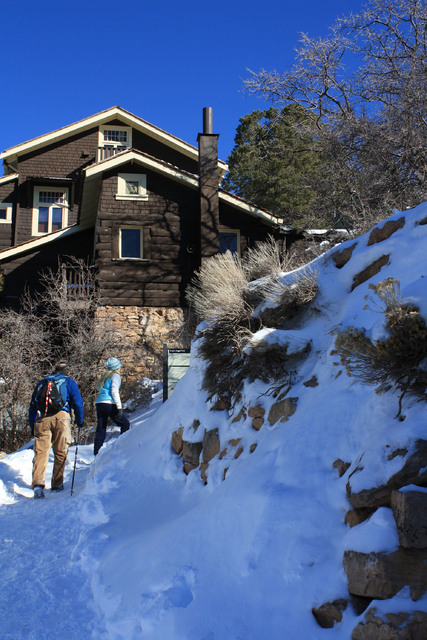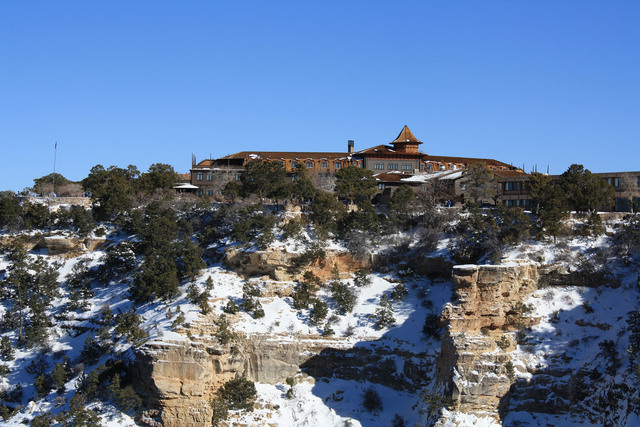Day Trips:Escape holiday stress with Grand Canyon visit
With the holidays upon us, many of us find personal stress reaching all-time highs, and our attention focused on material goods — not necessarily what we hope, but what in the world to give loved ones.
Neither condition is good, and for once I am going to suggest that running away, contrary to conventional wisdom, may be the perfect cure. A family trip to some national park can remove you from the pressure cooker of commercialized Christmas, force togetherness, and perhaps even start a new family tradition.
Many parks would serve, but none better than the South Rim of Grand Canyon National Park, Arizona. Though one of our most crowded parks most of the year, right now it can offer you something approaching solitude. Yet it can also be perhaps the most beautiful time of year there; at an elevation of 7,000 feet, a fresh blanket of snow will enhance the canyon’s beauty for many days, making natural colors and textures seem to pop out like a 3D movie on the widest screen imaginable.
While just gazing into the canyon from different viewpoints is a once-in-a-lifetime experience, outdoor people will also want to hike at least one of the trails.
The 13-mile Rim Trail, mostly paved, is well-suited for just about anyone, young or old. Its accessibility at multiple points allows you to select a segment to hike and return the way you came.
But there’s a little more adventure in descending a ways into the canyon. I recommend the Bright Angel Trail for that purpose. It’s one of the park’s most famous trails, and easily found, just west of the Bright Angel Lodge. Because the upper reaches of this trail can be hazardous with snow, ice, or both, be sure to wear a pair of over-the-shoe traction devices such as STABILicers or Yaktrax, and use a pair of sturdy hiking poles. These handy gadgets are easily found at outdoor stores such as REI or available at the Grand Canyon Market Plaza.
Just a few hundred yards after leaving the trailhead, you will walk through a man-made tunnel in the rock. Just after the tunnel, look high up on the cliff wall into a small alcove named Mallory’s Grotto. There you will see Native American pictographs — red paintings on the rock, depicting elk. Bring binoculars for a better look.
While hiking you might encounter a picturesque, wrangler-led mule train, as these trains carry passengers into the canyon year-round. If you would prefer to be on the mule, make advance reservations by calling (303) 297-2757. Sometimes they can even accommodate you at the last minute if you call (928) 638-2631 and ask to be put on a waiting list.
Another benefit this time of year is being able to drive your personal car on the 17-mile scenic Hermit Drive. It will be closed to private vehicles after Feb. 28, and until next fall will be accessible only by shuttle bus. At the end of this drive is Hermit’s Rest itself, a small building erected in 1914 and built to appear part of the natural landscape; its architectural ingenuity was one reason it has been designated a National Historic Landmark.
Be sure also to head in the other direction and visit Desert View, 25 miles east of the Grand Canyon Village. The best viewpoint there is reached by climbing the 85 stairs in the watchtower itself. It is open from 9 a.m. to 4:30 p.m.
Although one comes here to enjoy the outdoors, try to make time to go inside the visitor center and see the park orientation film “Grand Canyon: A Journey of Wonder.” If I haven’t visited a park before, I always begin with the orientation film, to get a feeling of the park and make mental notes of points I want to visit there. The movie is 20 minutes long and is shown on the hour and half-hour daily, starting at 8:30 a.m., with the last showing at 4:30 p.m. The Grand Canyon Visitor Center winter hours are 8 a.m. to 5 p.m. For more general information on Grand Canyon National Park, mule rides and available lodging in the area call (928) 638-7888 or www.nps.gov/grca.
Directions
- From Pahrump take NV-160 south about 52 miles to Las Vegas.
- Merge onto I-215 east and drive about 12 miles.
- Merge right onto U.S. 93 south for about 90 miles into Kingman, Arizona.
- Go east on I-40 for about 112 miles to Williams. Exit onto Arizona Route 64 and drive north for about 60 miles to the entrance to Grand Canyon National Park.
Deborah Wall is the author of “Base Camp Las Vegas, Hiking the Southwestern States,” “Great Hikes, A Cerca Country Guide,” and co-author of “Access For All, Touring the Southwest with Limited Mobility.” Wall can be reached at Deborabus@aol.com.


















